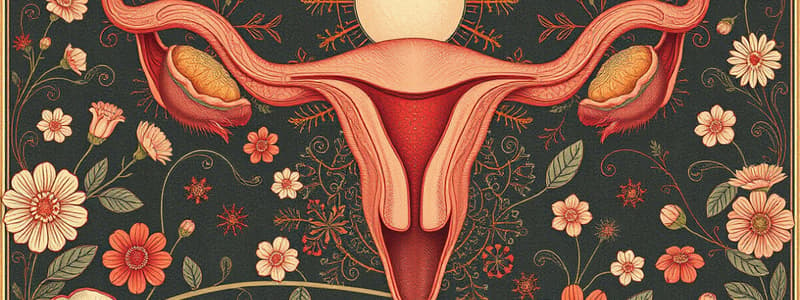Podcast
Questions and Answers
Which of the following symptoms is NOT considered a warning signal of pregnancy?
Which of the following symptoms is NOT considered a warning signal of pregnancy?
- Severe headache
- Clear fluid per vaginum
- Increased appetite (correct)
- Decrease in fetal movements
What relief measure is recommended for managing backache during pregnancy?
What relief measure is recommended for managing backache during pregnancy?
- Use a firm mattress
- Wear high heeled shoes
- Engage in high-impact exercises
- Support the back when sitting with a pillow (correct)
Which immunization is contraindicated during pregnancy?
Which immunization is contraindicated during pregnancy?
- Tetanus Toxoid (TT)
- Rubella Vaccine (correct)
- Hepatitis A Vaccine (HAV)
- Rabies Vaccine
What is the primary cause of nausea and vomiting, known as morning sickness, during early pregnancy?
What is the primary cause of nausea and vomiting, known as morning sickness, during early pregnancy?
Which condition may indicate the need to avoid air travel during pregnancy?
Which condition may indicate the need to avoid air travel during pregnancy?
Which statement about the ovulation process is accurate?
Which statement about the ovulation process is accurate?
Capacitation is essential for which of the following processes?
Capacitation is essential for which of the following processes?
Which reaction helps prevent polyspermy during fertilization?
Which reaction helps prevent polyspermy during fertilization?
What occurs immediately after the fertilization of the ovum?
What occurs immediately after the fertilization of the ovum?
Which enzyme is activated for sperm penetration into the zona pellucida?
Which enzyme is activated for sperm penetration into the zona pellucida?
Study Notes
Ovulation and Fertilization
- Ovulation occurs around day 14 in a typical 28-day cycle; the follicle bursts, expelling the oocyte into the uterine tube.
- The fimbrial end of the fallopian tubes captures the ovum, facilitated by ciliary movement and peristalsis of the tube.
- Fertilization requires a mature ovum and capacitated sperm; two key processes are capacitation and the acrosomal reaction.
Capacitation and Acrosomal Reaction
- Capacitation enhances sperm ability to penetrate the ovum, taking 2-6 hours, influenced by cervical and tubal secretions.
- Acrosomal reaction involves the removal of the acrosomal membrane, releasing enzymes for penetration through the corona radiata and zona pellucida.
Zygote and Early Development
- After fertilization, the zygote has areas: perivitelline space, zona pellucida, polar bodies, and the sperm.
- Zonal reaction and cortical reaction prevent polyspermy by altering zona pellucida properties and releasing cortical granules.
Cleavage and Morula Formation
- Cleavage, the rapid division of the zygote into blastomeres, starts approximately 30 hours after fertilization.
- By three days post-fertilization, a morula (12-16 cells) is formed as the zygote travels to the uterus.
Early Pregnancy Considerations
- Avoid coitus and travel during the first trimester and last six weeks of pregnancy.
- Immunizations recommended include TT, HAV, HBV, and rabies; live virus vaccines are contraindicated.
Warning Signals of Pregnancy
- Symptoms that warrant medical attention include vaginal bleeding, severe headaches, blurred vision, epigastric pain, oliguria, severe edema, decreased fetal movements, abdominal pain, urinary infections, and clear vaginal fluid (PROM).
Minor Complaints During Pregnancy
- Backache: Caused by lumbar lordosis and ligand relaxation; relief through adequate rest and support.
- Nausea and Vomiting: Known as morning sickness; manageable by eating dry foods and avoiding heavy meals.
- Gingivitis: Resulting from increased vascularity, often improves post-pregnancy; maintain dental hygiene.
- Ptyalism (Sialorrhoea): Increased saliva may occur; no treatment typically needed.
- Leg Cramps: Can be caused by serum calcium depletion; relief involves muscle massage and calcium gluconate.
- Urinary Symptoms: Increased frequency and stress incontinence due to pressure from the uterus.
Preeclampsia
- Preeclampsia is a serious condition arising after 20 weeks gestation, characterized by hypertension and proteinuria.
- Incidence is 6-8% of all pregnancies, contributing significantly to maternal morbidity and mortality; more common in primigravida, especially older women.
Female Pelvic Measurements
- Key pelvic outlet measurements include transverse diameter (11 cm), transverse midplane (10.5 cm), and anteroposterior diameter (13.5 cm).
- Thorn's Dictum suggests spontaneous delivery requires a combined transverse and posterior sagittal diameter of at least 15 cm.
Pelvic Anatomy
- Key pelvic joints include the sacroiliac, sacrococcygeal, and symphysis pubis.
- Important ligaments: sacrotuberous, sacroiliac, and iliolumbar.
Labor Signs
- Prodromal labor signs include lightening, cervical changes, and Braxton-Hicks contractions (false labor).
- Lightening occurs when the fetal presenting part descends, causing changes in abdominal shape and increased pelvic pressure.
- Cervical softening and dilation occur as labor approaches, indicating readiness for delivery.
Studying That Suits You
Use AI to generate personalized quizzes and flashcards to suit your learning preferences.
Related Documents
Description
Test your knowledge on the human reproductive cycle with this quiz. It covers key processes such as ovulation, follicle function, and fertilization. Perfect for students studying human biology or related fields.




